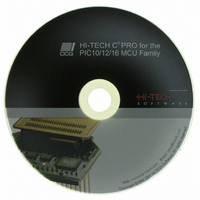SW500010 Microchip Technology, SW500010 Datasheet - Page 122

SW500010
Manufacturer Part Number
SW500010
Description
HI-TECH C PRO FOR PIC10/12/16
Manufacturer
Microchip Technology
Type
Compilerr
Series
PIC10/12/16r
Specifications of SW500010
Supported Families
PIC10, PIC12, PIC16
Core Architecture
PIC
Software Edition
Professional
Kit Contents
Software And Docs
Mcu Supported Families
PIC10/12/16
Tool Type
Compiler
Lead Free Status / RoHS Status
Not applicable / Not applicable
For Use With/related Products
PIC10, PIC12, PIC14, PIC16, PIC16E
Lead Free Status / Rohs Status
Lead free / RoHS Compliant
Other names
019P
778-1006
778-1006
778-1006
778-1006
- Current page: 122 of 502
- Download datasheet (3Mb)
HI-TECH C Assembly Language
tions defined and accessed in assembly code.
4.3.4 Constants
4.3.4.1 Numeric Constants
The assembler performs all arithmetic with signed 32-bit precision.
as given in Table 4.3.
fiers. Hexadecimal digits are accepted in either upper or lower case.
temporary (numeric) label backward references.
format.
4.3.4.2 Character Constants and Strings
A character constant is a single character enclosed in single quotes ’.
or newline characters, enclosed within matching quotes. Either single quotes ’ or double quotes "
maybe used, but the opening and closing quotes must be the same.
4.3.5 Identifiers
Assembly identifiers are user-defined symbols representing memory locations or numbers. A sym-
bol may contain any number of characters drawn from the alphabetics, numerics and the special
characters dollar, $, question mark, ? and underscore, _.
e.g. Fred is not the same symbol as fred. Some examples of identifiers are shown here:
122
This comment string may also be used in assembler source to achieve the same effect for loca-
The default radix for all numbers is 10. Other radices may be specified by a trailing base specifier
Hexadecimal numbers must have a leading digit (e.g. 0ffffh) to differentiate them from identi-
Note that a binary constant must have an upper case B following it, as a lower case b is used for
In expressions, real numbers are accepted in the usual format, and are interpreted as IEEE 32-bit
Multi-character constants, or strings, are a sequence of characters, not including carriage return
The first character of an identifier may not be numeric. The case of alphabetics is significant,
Binary
Octal
Decimal
Hexadecimal
Radix
digits 0 and 1 followed by B
digits 0 to 7 followed by O, Q, o or q
digits 0 to 9 followed by D, d or nothing
digits 0 to 9, A to F preceded by Ox or followed by H or h
Table 4.3: ASPIC numbers and bases
Format
Macro Assembler
Related parts for SW500010
Image
Part Number
Description
Manufacturer
Datasheet
Request
R

Part Number:
Description:
Manufacturer:
Microchip Technology Inc.
Datasheet:

Part Number:
Description:
Manufacturer:
Microchip Technology Inc.
Datasheet:

Part Number:
Description:
Manufacturer:
Microchip Technology Inc.
Datasheet:

Part Number:
Description:
Manufacturer:
Microchip Technology Inc.
Datasheet:

Part Number:
Description:
Manufacturer:
Microchip Technology Inc.
Datasheet:

Part Number:
Description:
Manufacturer:
Microchip Technology Inc.
Datasheet:

Part Number:
Description:
Manufacturer:
Microchip Technology Inc.
Datasheet:

Part Number:
Description:
Manufacturer:
Microchip Technology Inc.
Datasheet:










